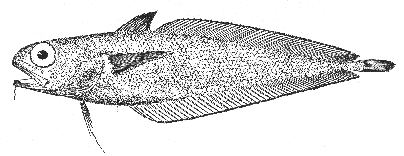Hakeling Physiculus fulvus Bean 1884
[Jordan and Evermann, 1896-1900, p. 2547.]

Figure 113.—Hakeling (Physiculus fulvus), outer edge of Continental Shelf off Nantucket. From Goode and Bean. Drawing by H. L. Todd.
Description—
This fish is hakelike in its general appearance, also in the general arrangement of its [page 234] fins, for it has two dorsals, the first (10 rays) triangular and much shorter than the second (about 49 rays) which is of nearly uniform height from end to end; one long anal fin (about 54 rays) which is similar to the second dorsal in shape; and ventral fins situated in front of the pectorals. It is separable from the white, squirrel, and long-finned hakes (genus Urophycis, pp. 221 and 232) in that its anal fin originates in front of the origin of the second dorsal fin instead of considerably behind the latter and that its ventral fins have 5 rays each instead of 2 and are much shorter than those of the true hakes, with the longest ray (the second, which is filamentous at the tip) hardly reaching back as far as the middle of the pectoral fins. Furthermore, the snout of the hakeling is blunter than that of any true hake; its caudal fin much smaller; its body tapers more abruptly; and none of the rays of its first dorsal fin are prolonged.
Color—
Described as light yellowish brown with the lower surface of the head, the abdomen, and the margins of the dorsal and anal fins very dark brown, and with a dark brown blotch on each cheek (on the subopercular bone). We have not seen it fresh from the water.
Size—
The maximum size is not known.
Habits—
Nothing is known of the habits of the hakeling except that it is a deep-water fish, having been taken from 79 fathoms down to 955 fathoms, where it lives on or near the bottom, to judge from its general structure.
General range and occurrence in the Gulf Of Maine—
This hakeling has been taken at several localities in the Gulf of Mexico and on the continental slope off the eastern United States. The most northerly record for it is off Nantucket (lat. 40° 01' N., long. 69° 56' W.) in 79 fathoms, and it is on this record that the hakeling is mentioned here.[60]
[60] Another small hakeling (Lotella maxillaris) has been taken off Marthas Vineyard. It is separable from the hakeling described above by the fact that its anal fin originates behind the origin of the second dorsal fin, and by its larger teeth.